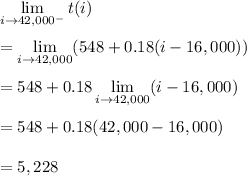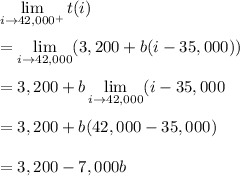t(i) will be continuous at i = 42,000 if
• the limits of t(i) as i approaches 42,000 from either side both exist, and
• both of these limits agree with the value of t(i) at i = 42,000
By definition of t(i), we have
t (42,000) = 548 + 0.18 (42,000 - 16,000) = 5,228
Now check the one-sided limits - both must have a value of 5,228.
• From the left:

• From the right:

Solve for b :
5,228 = 3,200 - 7,000 b
7,000 b = -2,028
b = -507/1750 ≈ -0.2897